
Score breakdown
Things we like
- Modern/old-school mechanicals
- Still sharp value
- If it ain't broke...
Not so much
- 1.5L 'purists' won't be happy
- No LSD for auto
Mazda’s ubiquitous MX-5 has been proving that there’s a demand for a small, lightweight and affordable sportscar in virtually every global market for more than 30 years.
Over four generations, the iconic model has never fallen into the technological trap of speed and potency at all costs, and it’s the pursuit of purity that has won a large loyal audience and the title of the world’s most successful two-seat convertible.
The key to this success has been incremental improvement, although a full reset for the current 'ND' generation in 2015 resurrected an MX-5 that was as small and light as the original.
It's a recipe that continues to be almost unique in the modern market, but Mazda is still continually enhancing the ND with small but valuable improvements –including the latest 2022 update.

Firstly, the dwindling 1.5-litre version is gone and while the die-hards will be running around crying infamy and waving their hands in the air, it’s actually a logical move. At launch, the smaller engine offered a less powerful but more revvy and involving option over the more effortless 2.0-litre, but a mid-life update imparted that same free-revving nature to the bigger engine and essentially pinched the 1.5’s USP.
With the removal of the entry 1.5L Roadster (convertible), the MX-5 range is effectively more expensive as the most affordable 2.0-litre is priced $1600 more at $37,790 before on-road costs.
But that’s significantly less cash than the previous entry 2.0-litre, which was only available in more premium GT trim. That means the new MX-5 Roadster range-opener is more powerful and faster, but $6230 cheaper than the previous 2.0-litre.
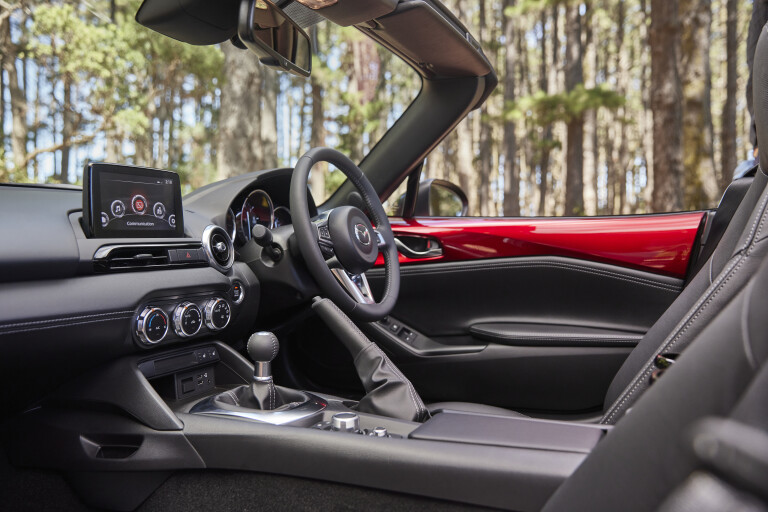
The GT and RS are still available for MX-5 lovers with a bigger budget, as is the RF (retractable fastback) hard-top in the same entry, GT and RS variants. A new Platinum Quartz paint colour and Terracotta leather for the RF GT rounds out the more conventional range revision, but there is one more intriguing addition for all versions in 2022.
New to the model is Mazda’s Kinematic Posture Control (KPC) which is not, as the name suggests, some kind of seat massage function, but a special evolution of Mazda's chassis and dynamics control.
The Haunted Hills Hillclimb track’s tight twisting corners was the perfect venue to demonstrate KPC and, after a few laps, the benefit was clear
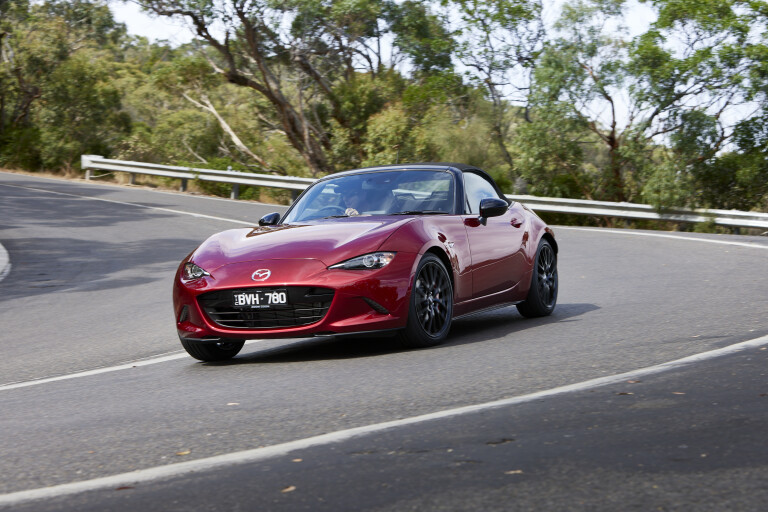
Quite simply, when the MX-5 turns into a corner at any speed, the revised stability electronics lightly apply the inside rear brake. It’s not enough to decelerate the car or noticeably alter its composure but the gentle action tightens the turn and prompts a more eager turn-in. It’s essentially the same principle as Mazda’s G Vectoring, which rolled out with the Mazda3 in 2016, but now evolved for the rear axle.
If the principle sounds familiar, you may be recalling the simple but brilliant Brake Steer system McLaren introduced with its 1997 Formula One car.
Unlike KPC, McLaren’s so-called ‘Fiddle Brake’ was manually operated by the driver using an extra brake pedal but uses exactly the same principle as Mazda’s automatic approach. In F1 it was worth half a second per lap, and in the MX-5 it means an enhancement of driving dynamics and responsiveness without having to deal with a fourth pedal.

You might argue that an enhancement this subtle might be more the effect of the power of suggestion rather than a perceptible improvement, but a direct back-to-back comparison allayed any fears that I had been plied with the Mazda Kool-Aid.
The Haunted Hills Hillclimb track’s series of tight twisting corners was the perfect venue to demonstrate KPC and after a few laps in the pre-update version followed by the 2022 model, the benefit was clear.
In some cases, hitting an apex is easier, with an apparent willingness to cut a tighter line – this effect is particularly noticeable with off-camber corners where the car has a tendency to push to the outside of the track. In other corners, the MX-5 hugged the inside kerb from entry to exit rather than finding a line that starts wide and tightens to the apex.
The little lean into corners before stabilising is still one of the MX-5’s unique and hugely likeable trademarks – and is unchanged with this update

Unlike the G Vectoring system that required almost laboratory tests to demonstrate, KPC is far more obvious and actually required a couple of laps of adjustment to find a different but faster line. Despite the reduced lap times, the system is less about speed and more about enhancing the MX-5’s friendly and involving nature, which it certainly does.
Away from the track, the revised model is still a complete joy and there are few cars that can slap an almost uncomfortably wide smile on your face when the sun is out and the way ahead is twisty. Most importantly, the new system has not flattened out the MX-5’s manners in real-world cornering.
The little lean into a corner before stabilising and executing the bend is still one of the MX-5’s unique and hugely likeable trademarks – and it is unchanged with the update.
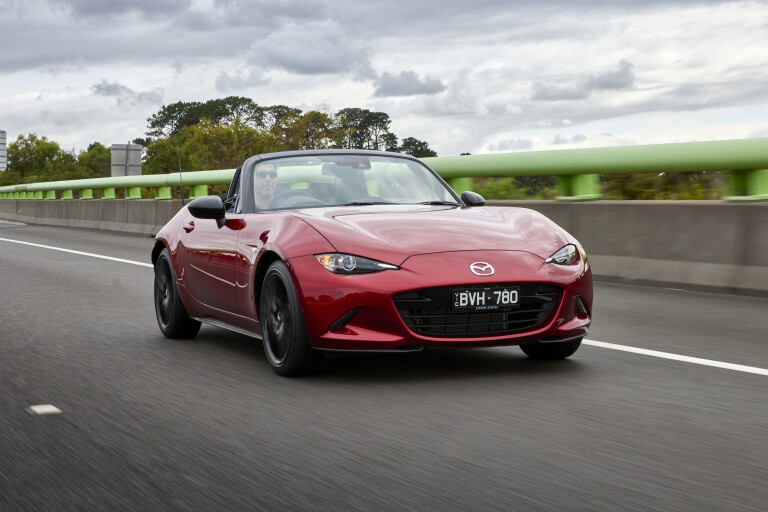
Also unchanged is the sweet steering and slender 'wheel, supple ride and compliant body control – even with the more track-focused RS, which carries over following its introduction last year. Its combination of Bilstein dampers and front strut brace is complemented by the new chassis program to create an MX-5 that feels more responsive and rewarding than any before it.
Most impressively though, the introduction of the new system was achieved through electronics alone, requires no additional hardware, and has added no extra kilos to the model’s bantamweight.
Mazda is a master of subtle improvement through clever engineering and the introduction of KPC is a great example of its innovation
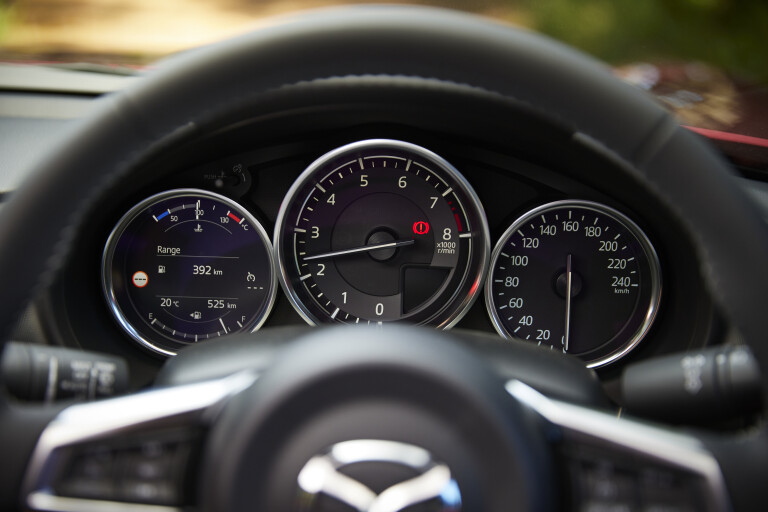
Acceleration thanks to the more advanced 2.0-litre is strong and the ridiculously light 1052kg kerb weight makes its 135kW and 205Nm seem like a lot more.
Under hard braking, the four-piston Brembo front brakes of the RS seem to reduce the mass even further still with a beautifully positive feel and minimal pedal travel.
All versions are available with a six-speed automatic transmission, which is fine, but the six-speed manual is really the only way to go with a car like this. That, and you’ll be carrying an extra bag of cement in weight while missing out on the mechanical feel of the gear shift and aggressive clutch action. Mazda’s customers appear to agree, with more than half of MX-5 sales in favour of the self-serve 'box.
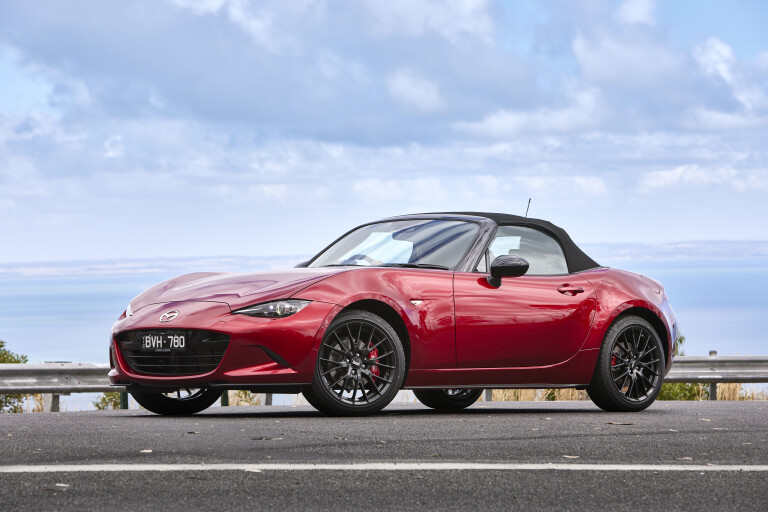
Mazda is a master of subtle improvement through clever engineering and the introduction of KPC is a great example of its innovation, working in harmony with the rules of physics rather than trying to bludgeon them into submission.
Updating and making changes to a model that is so close to the perfect purist’s driving experience is inherently risky but like the introduction of the more focused RS variant last year, Kinematic Posture Control is another welcome addition to the MX-5’s long list of attributes.
Score breakdown
Things we like
- Modern/old-school mechanicals
- Still sharp value
- If it ain't broke...
Not so much
- 1.5L 'purists' won't be happy
- No LSD for auto



COMMENTS